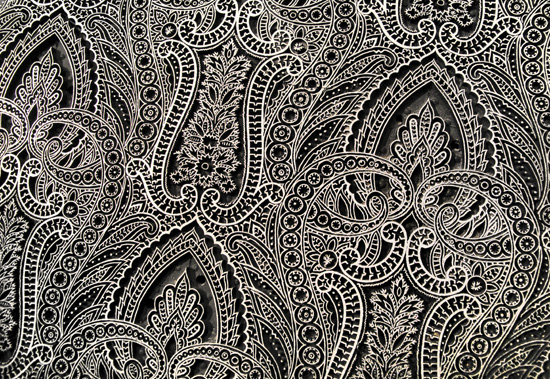
by Maureen | Mar 17, 2010 | Discoveries, Featured Articles, Graphics, Journal, Photo of the Day, Photos
When here in Milano in the summer of 2008, I stumbled upon a Zucchi Store just a half block north of the Duomo. They sell lovely household linens (sheets and towels) and they had a curious display in the window. I didn’t understand what I was seeing, so I had to go in.
Emerging up through a very large, circular hole in the first floor was a towering stack of flat wooden blocks. What were the blocks? It was then that I found out about the Zucchi Collection of wood-and-pewter blocks for printing fabric.
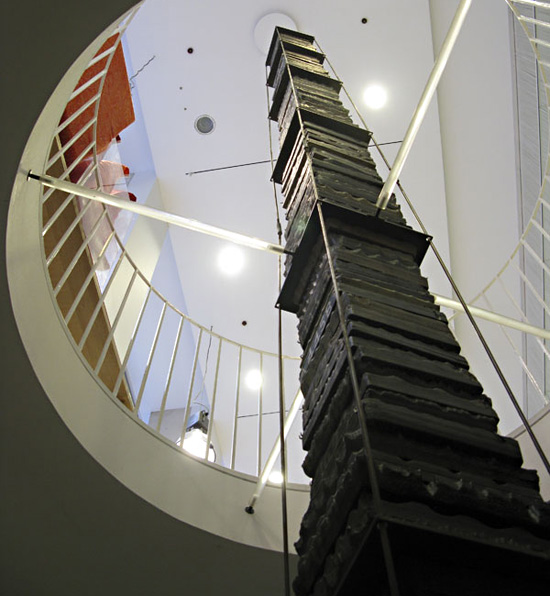
From the Zucchi Website: “The Collection’s 12,000 designs bear witness, over a period which spans three centuries from 1785 to 1935, to a fashion that was both varied and popular. Such tastes were apparent during one of the most energetic and fertile periods of European culture, which ended with the first stylistic experiments of the Art Nouveau and Art Deco movements.
“The Collection houses 56,000 printing blocks, an extraordinary number by any reckoning and one which presents concrete problems not only of space but also of storage in structures able to support the weight of many tonnes. The Collection is housed in three different storage locations: the Zucchi office in Casorezzo, the Via Foscolo location in Milan and a warehouse in Ossona.
“To make the Collection accessible not only to scholars but also to the fashion people, it was necessary to choose criteria by which the artefacts could be subdivided. The Zucchi Collection has been divided into six categories, which are identified in terms of iconographic forms: abstract, cashmere, floral, geometric, ornamental and pictorial. The Collection has been further subdivided according to the specific uses not only for the borders of the materials but also for foulards, bandanas, various ties, scarves and cravats, etc. A special data card, in computerised and paper formats, has been assigned to every series of blocks. Each of these contains various items of information about the handblock concerned, including the number of pieces which make up the structure, the design style it is capable of reproducing, its historical period and its origins. Attention has also been given to the question of conserving these structures and rightly so because the wood is sensitive material. The humidity and temperature levels require strict control and beeswax and turpentine must be applied to maintain the elasticity of the wood.”
A mere fraction of the collection has been on display on the lower floor of the Zucchi Store, including floor-to-ceiling, wall-to-wall shelves holding the numbered wood blocks. (They are now in the process of moving these blocks to another location.) Note that some designs have 3-5 different blocks to create the full design. (They are all numbered alike.) Being a lover of textiles I was immediately enamored of the collection.
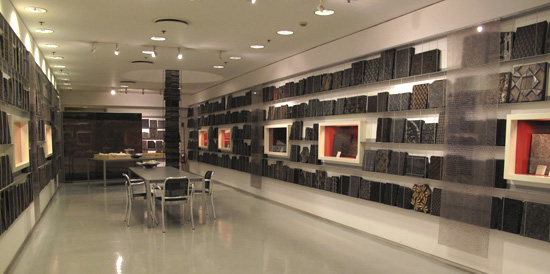
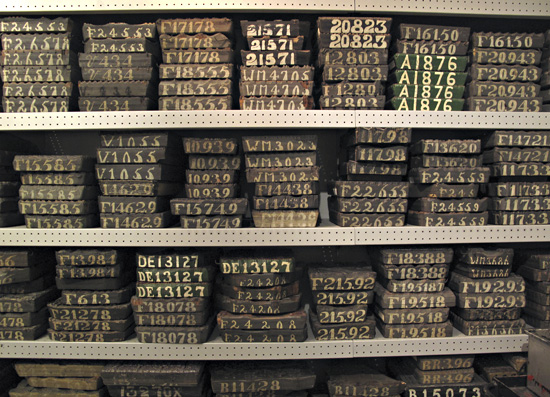
Fast-forward almost 2 years and now I’m living in Milano. Last Fall I found a curious and creative textile studio not far away named “L’Hub” on the Naviglio Grande, the “big” canal. One, they were selling vintage Zucchi linen and cotton dishtowels from the mid- and late-1900s. (Yes. I bought a bunch.) Two, they offer all sorts of creative textile classes including dyeing, sewing, construction, AND printing fabric with the centuries-old Zucchi blocks! Can you say “Sign me up!”?
I enrolled in the 3-hour class held last Saturday afternoon, taught by artist Franco Duranti (at the very far left in the next photo). Among other things, Franco is a painter, engraver, and video artist AND since 2007, he’s been creating original works with the Zucchi wood blocks! Below is a photo of the working studio at L’Hub. Some women were taking a sewing class, while two other women were also taking the fabric stamping class.
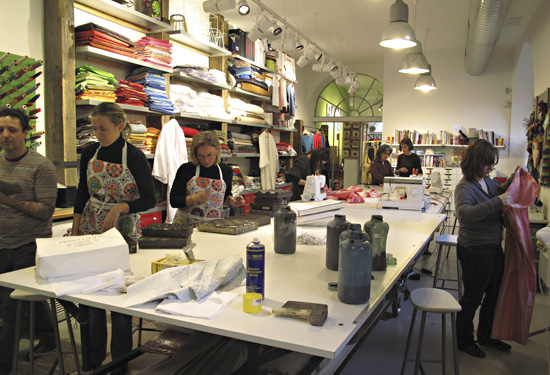
I wanted “classic”. I had just seen the Frette Textile Exhibit a week ago. I’m enthralled by the traditional fabric handwork of generations past and am especially inspired by my Great Great Grandmother’s work, done at age 12 in 1861. She crafted a cross-stitch sampler in “Turkey Red” on cream-colored cloth, and that color combination has launched me ever since my Grandmother gave me the sampler in 1975.
On the neighboring streets (on that recent day when I was getting snowflakes in my eyes) I scouted fabric stores and came away with Italian, 100% Linen. I bought a meter of fabric and took it home to prewash.
In familiarizing myself with the printing process, I chose a simple fleur-de-lis pattern printed in “carminio” – carmine red – on the linen. Note how, in this case, the block carries an “island” of cast pewter attached to the wood,
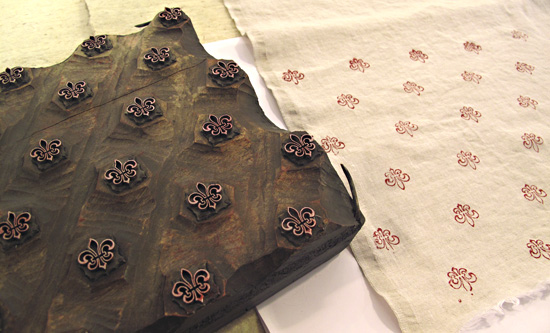
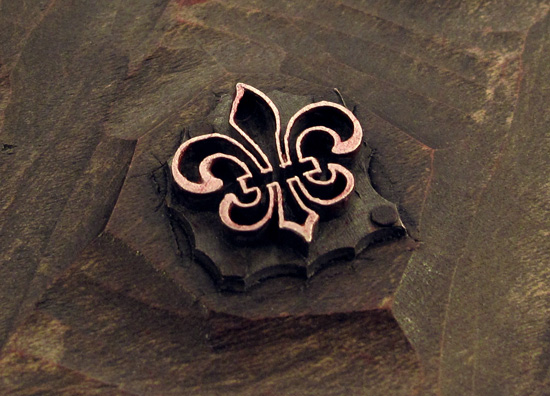
The following is an intricate, cast-pewter, paisley design from the “Cashmere” group of blocks in the collection. THIS makes my heart melt! Unfortunately, I was not able to print with this block, but printed with one I found that was as close as possible.

In gathering fabric for printing, I had also gone BACK to the Zucchi store downtown and they just happened to be having a sale! I bought two sets of sheets. One set is 100% cotton, satin finish with a subtle, printed khaki/cream pattern. I printed right over the top of the pattern to create a set of sheets like no other in the world.
I also paid a visit to the second-hand store 2 blocks away. I found white, cotton button-end pillowcases and bought all six at 2 euro each (about $2.75) When I got them home to wash them, I looked inside and noticed a… Zucchi label! Of course.
My plan now is to return to the L’Hub studio for a solo 3-hour stint to embellish the pieces I began, and to print even more.
As I wallow in Art and Design during my time here in Italy, I can’t imagine a more exhilarating addition to my list of design experiences than printing with the Zucchi handblocks at L’Hub!
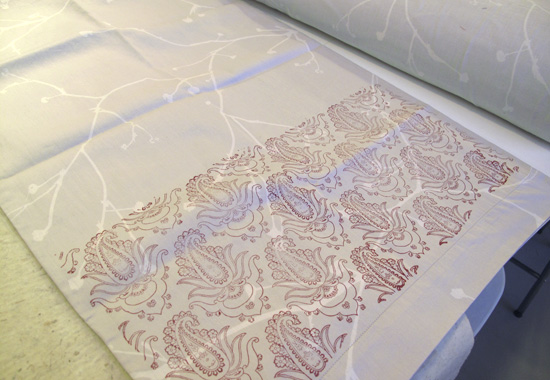
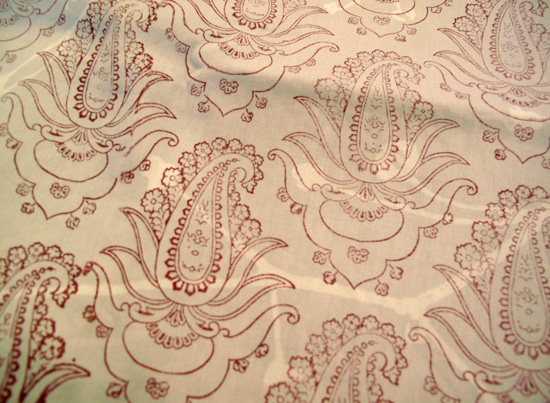
by Maureen | Mar 16, 2010 | Discoveries, Food!, Journal, Meals, Shopping & Markets
The other day I noticed the section in the meat department at the grocery store where they sell the “ends” of the prosciutto, mortadella, salami and other meats. I bought a prosciutto end for just a couple of euro; it was about the size of my fist.
Much of the meat was pretty dry, so without being sliced paper thin as is typical, it wasn’t optimal for eating. So: Prosciutto Soup! Besides. It was Sunday night and I hadn’t gotten to the grocery store in time so the pickins in my cupboard were slim.
I sauteed an onion and some garlic in olive oil. Cubed the prosciutto and threw it in the pan. I opened a can of fagioli borlotti, a bean that is white and speckled with deep magenta when freshly-shelled. I added a spoonful of vegetable bullion, but probably wouldn’t have needed to; it was WAY too salty, especially with the salt of the prosciutto. So I just kept adding water to the pot until the salt leveled out.
Everything simmered for about 3 hours and melded nicely while I sat here at the computer. The meat softened up. The beans thickened the broth a bit.
I’m probably breaking a lot of “rules” here, putting foods together in combinations quite atypical. But I came here without the food foreknowledge and preconceptions, so I simply see everything as an ingredient free-for-all. (That’s just how I cook, wherever I am.) Would a traditional cook make a soup such as this? I don’t know. If you know, please tell me!
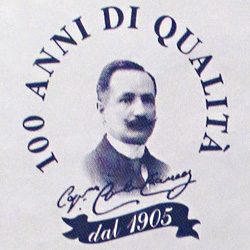
by Maureen | Mar 12, 2010 | Discoveries, Featured Articles, Journal, Photo of the Day, Photos
Milano is a fabulous place to do a “design intensive” exploration, and I’ve stepped up my voracious visual consumption of the rich details around me. What a place to study typography, graphics, signage and advertising! Everything captures my mind.
Even a toothpaste ad.
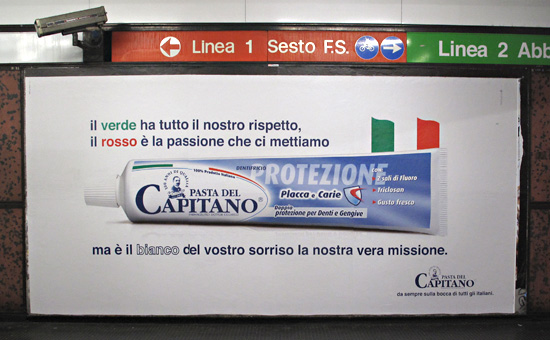
“The green has all our respect, the red is the passion we put into it,
but it’s the white of your smile that’s our true mission.”
No, not all Italian packaging has such a retro, stereotype look. One finds the usual Crest, Colgate and Sensodyne on the grocery shelves, but with Italian swapped for English. That must be why “Pasta del Capitano” seemed like such a throwback, and stopped me while rushing for the subway car.
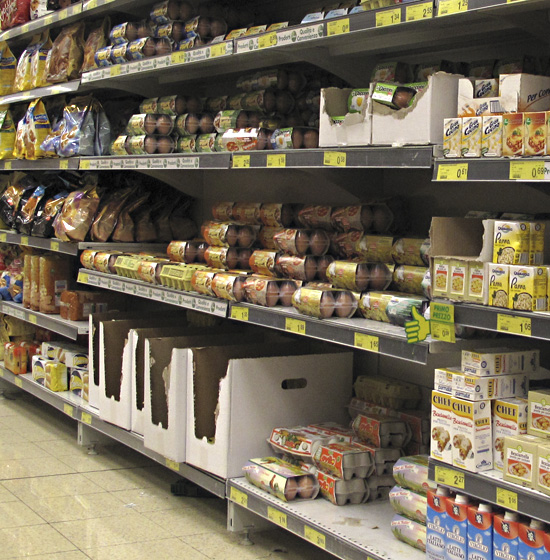
by Maureen | Mar 8, 2010 | Discoveries, Food!, Journal, Shopping & Markets
“Excuse me. Where are the eggs?” On my first grocery shopping trip last June, I searched all over the refrigerator section of the store to find the eggs. Where were they?! I finally asked, and was directed to the shelf across from the cereal, below the scotch tape and coffee maker parts, next to the milk and cookies.
Hmm. Curious. And they’re packaged in twos, fours and sixes. Also curious. Who needs to learn what from whom in this regard?
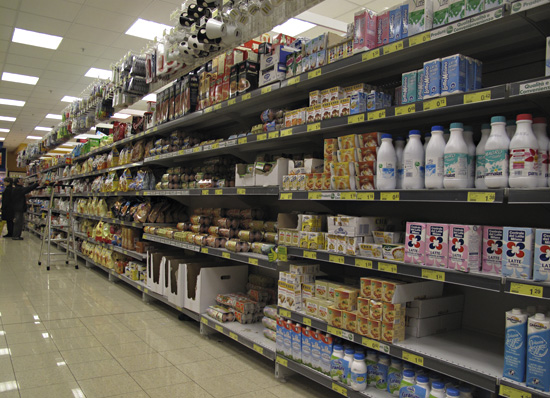

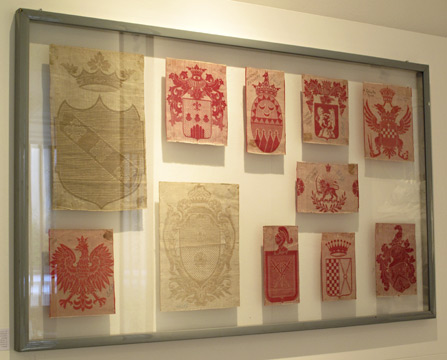
by Maureen | Mar 8, 2010 | Discoveries, Featured Articles, Graphics, Journal, Photos
When I rounded the corner and saw the wall of red and cream damask patterns, I skipped both a breath and a heart beat. These are the textiles I came for. These are the fabrics I prowl and lurk for at the antique fairs.
“The Thread of Dreams – Il Filo dei Sogni” is a show at the Palazzo Morando Costume Moda Immagine here in Milano. The show marks the 150 years of the Frette Linens company, 1860-2010. Absolutely gorgeous damask/jacquard patterns from the time of Frette’s beginning were gathered on a heart-stopping wall. I swooned. And then turned and strolled to look at them all.
Having been a seamstress for as long as I can remember, my heart rate really does pick up a few beats when in the presence of beautiful fabric. And, owning a red-on-cream embroidered piece from my great, great grandmother that she stitched at age 12 in 1861, I have a tremendous soft spot for that color combination. Combine those two joys and of course it was dreamlike for me to see this show!
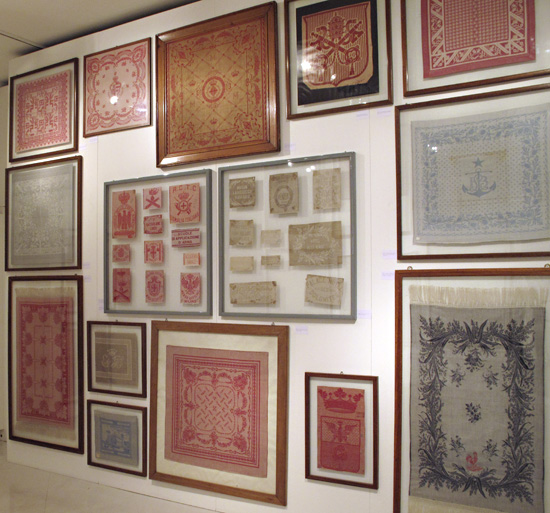
Original hand-painted and hand-drawn designs were shown side-by-side with the final woven fabric. A pleasure to see “the hand” of the designer. (And impossible to avoid glare and reflection in the exhibit space!)
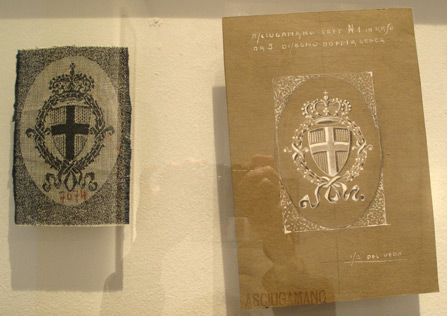

They showed overall patterns, borders, coats-of-arms, hotel emblems, nautical, floral and heraldic designs. If I were to bring home any “souvenir” from Italy, I would love to get my hands on one of these Frette fabrics, either vintage or modern day!
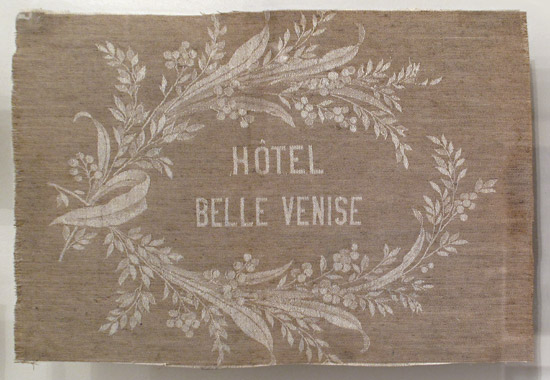
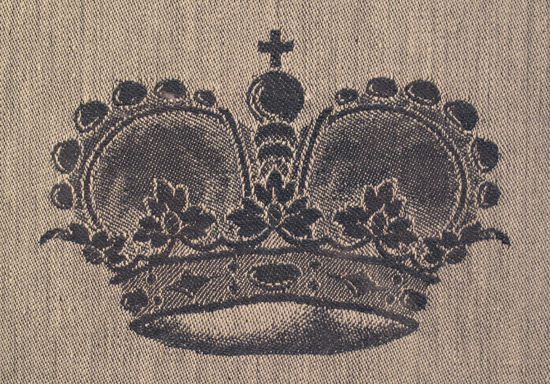
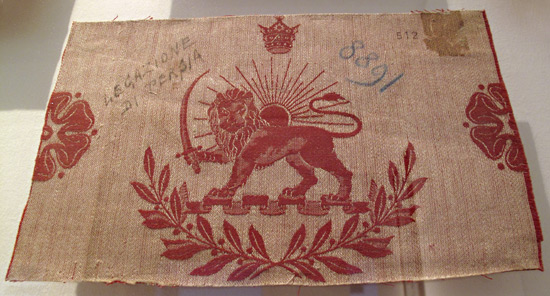
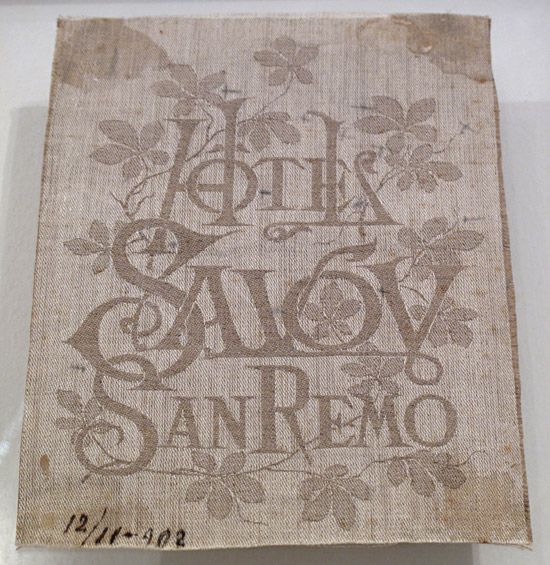
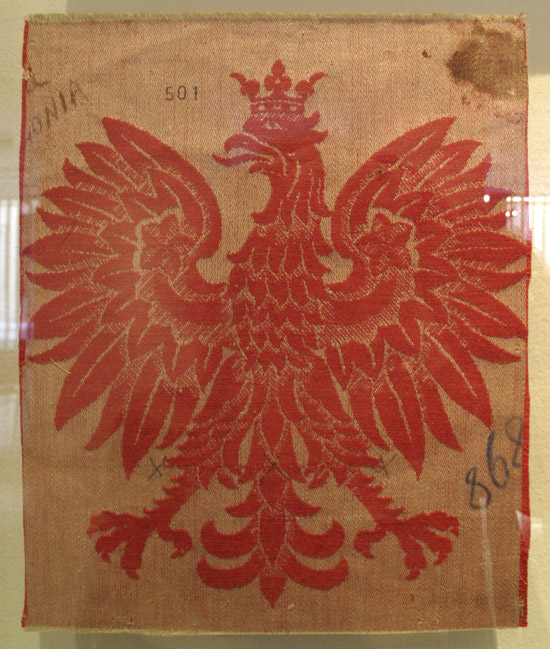
Why fight the reflection? Here’s a Frette self-portrait. (My sister is always saying “I want to see pictures of YOU over there,” so this is my way of complying with her request.)
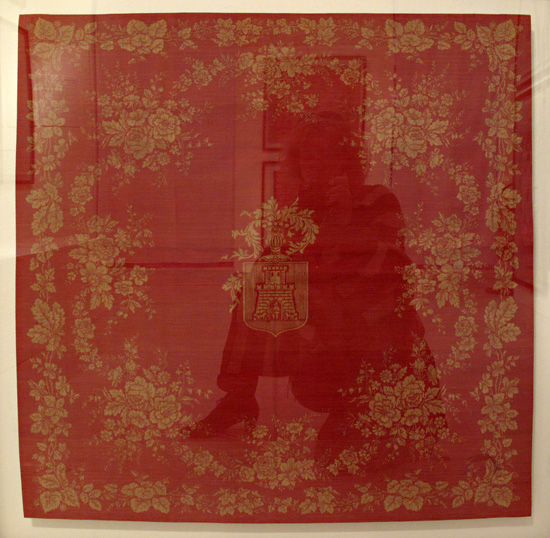
Currently, Frette is known for their very sumptuous bed linens. Ooo lah lah. A damask top sheet alone can be $250 or more and the fabric is supple and luxurious to the touch.
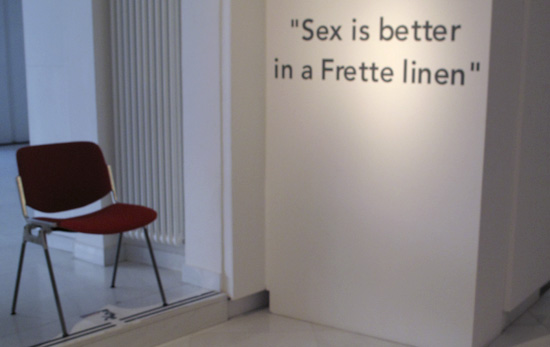
Part of the exhibit was a “mood wall” showing ideas, sketches, fabric samples and inspirations for a contemporary collection. I appreciate that they show original pencil drawings and a variety of renditions of a given motif all the way to the final fabric.
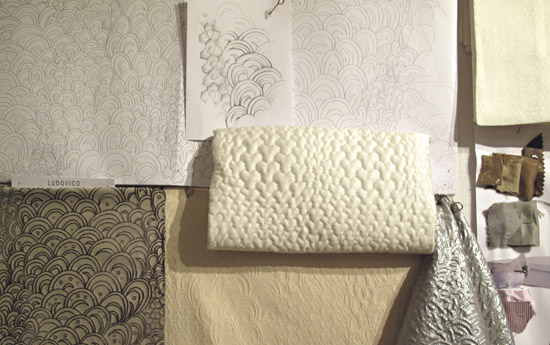
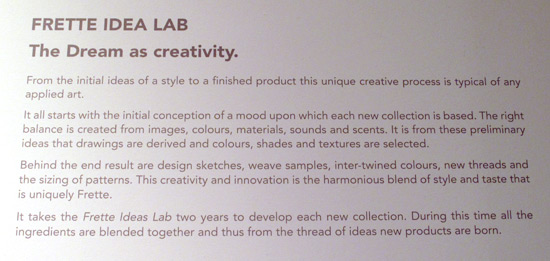
Another part of the show was an amusing, playful sculptural installation in an homage to Frette. I delighted in it as I walked into the room and circled.
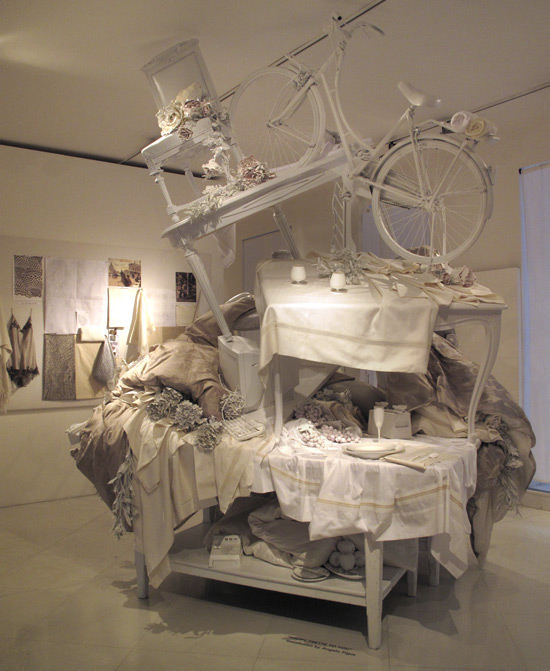
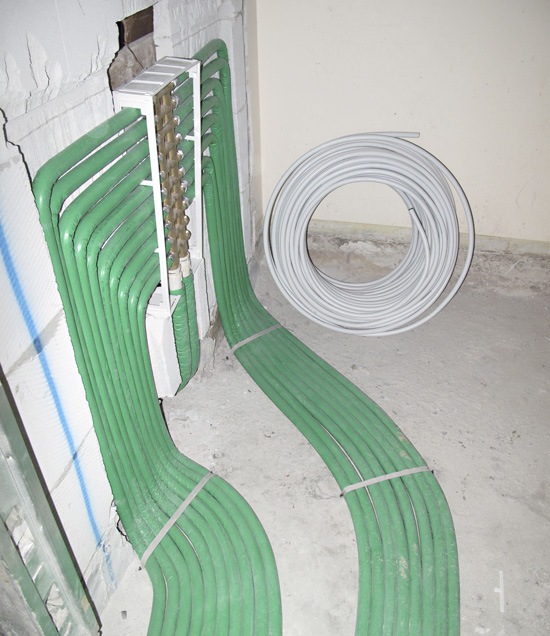
by Maureen | Feb 26, 2010 | Discoveries, Featured Articles, Incredible Locations, Journal, Photos, Sanremo
How many people travel to Italy and include construction shots in their set of “vacation photos”? When I went to see an apartment being remodeled I didn’t realize how fascinating it would be. (Then I thought of my family members and friends that would also be interested and I started shooting photos.)
This apartment, or condo, in a 50-year-old, 6-story building in Sanremo has been completely gutted, peeled of it’s stucco and old-time, old-lady wallpaper. I was struck by how DIFFERENT this construction is than our 2x4s on 16″ centers, skinned with sheetrock. Notice that everything is stone-based, (as are all structures here, except for high-rises). Even the interior walls are some sort of white plaster/concrete block. The old floor has been excavated to about 6-8 inches below final grade so they can lay down the new water and heating system.
In this photo we’re looking into the entry foyer with the front door inside and to the left.
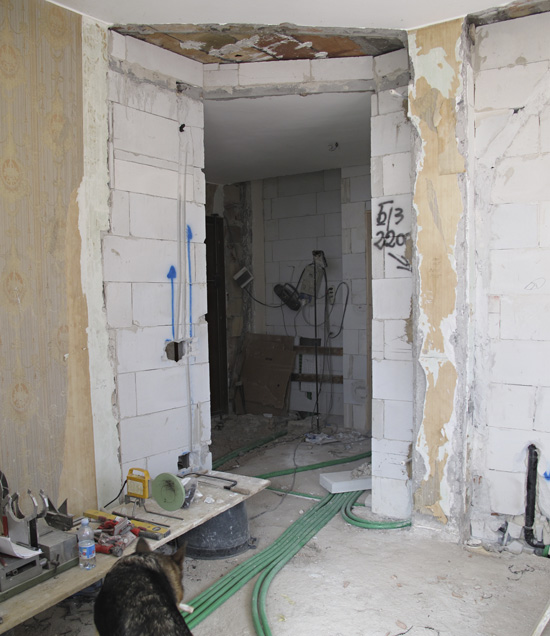
The hot water tubing is green, flexible and multi-layered. The cold water runs through the narrower, white tubing. Both have an interior plastic layer, surrounded by metal, surrounded by plastic. The hot water tubing is encased in fairly soft, green foam insulation. Each route is one continuous run of tubing, except for occasional t-joints. And, yes, you can walk on the tubing after it’s been set out and it won’t crush under normal foot traffic.
Why is there so much green tubing running through this two-bedroom apartment? All the homes here have wall-mounted radiator heaters. No forced-air heat. No baseboard, electric heaters that are typical in much of the U.S.
Note how the floor has been carved out to accommodate several layers of overlapping tubing. In the end, a thick layer of concrete will be floated over the whole floor, encasing all of the tubing and its structure. Ceramic floor tiles will be the finishing surface.
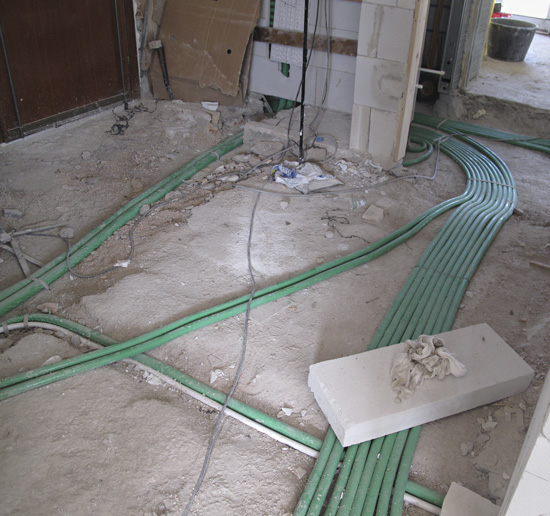
This is the main junction box where all tubing joins. Very neatly done! And notice how the snakes of tubing are anchored with woven strapping to the raw floor.

Here’s the tubing laid out for one of the two bathrooms. The black pipe is the wastewater route. Notice how they’ve simply gouged a groove into the cement block wall to position the tubing that runs upward for the shower.
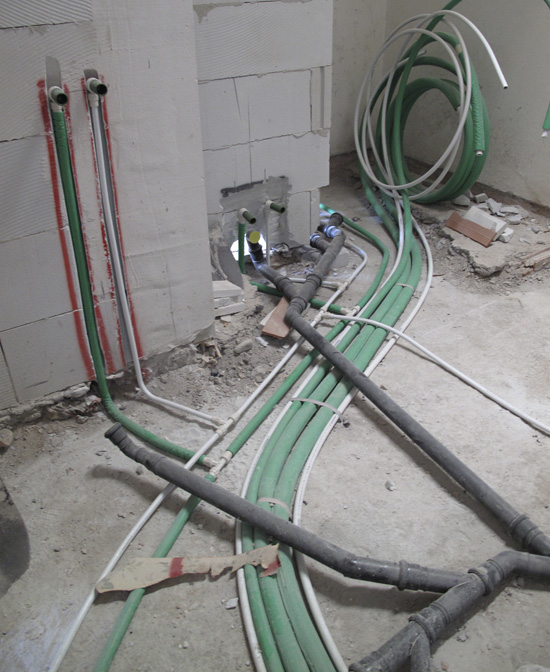
T-Joints and anchors. And I love that little diamond-shaped rough chunk of cement block spacing the white and green tubes.
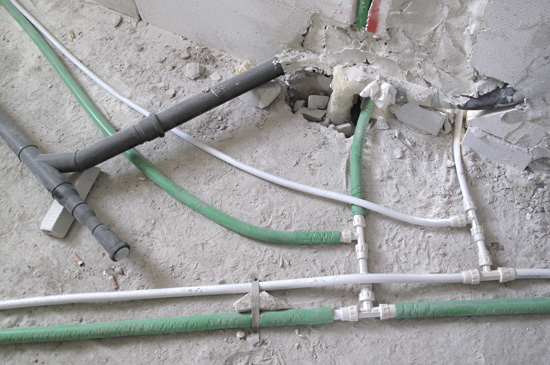
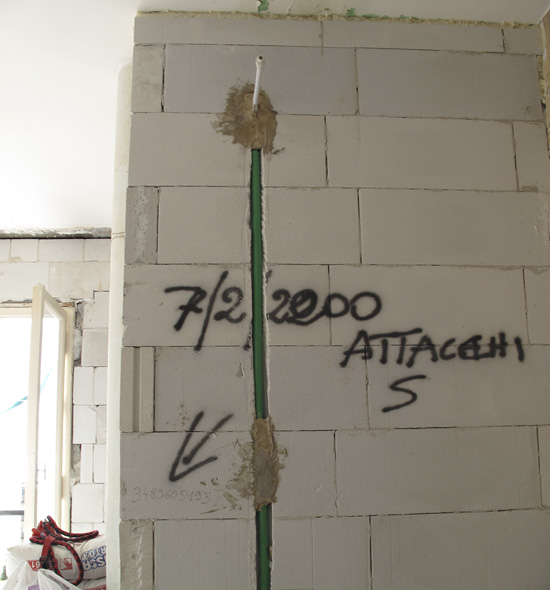
Do you know what this is (below)? This is the water supply for the flushing mechanism of the toilet and it, too, will be encased in the wall! My mind imagines potential problems down the road with the system and having to rip apart the floor and wall for repair. Ugh.
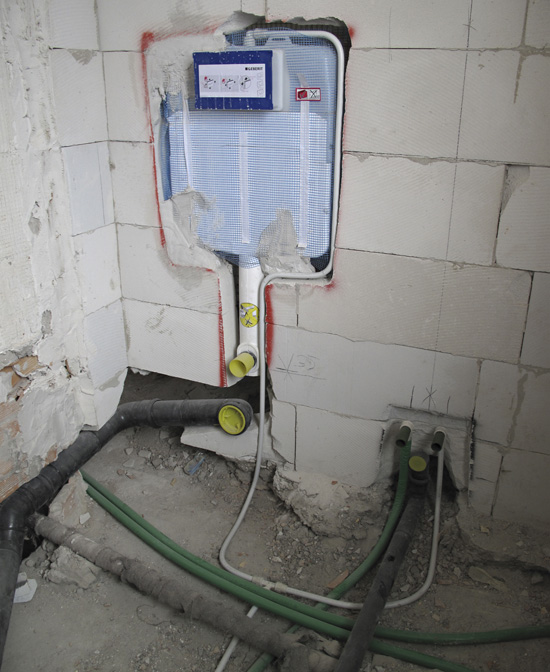
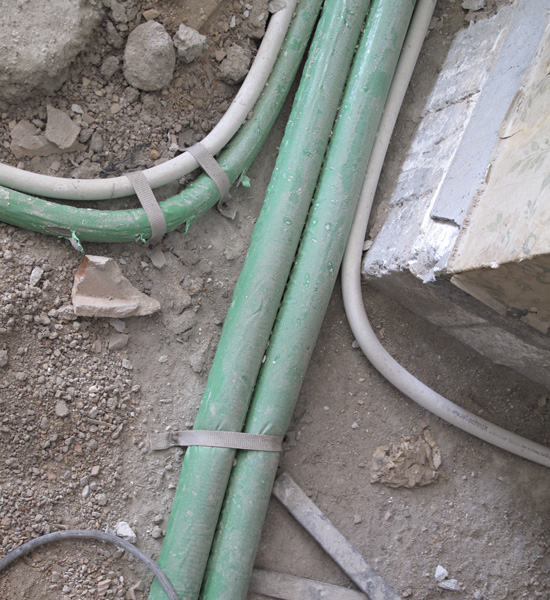
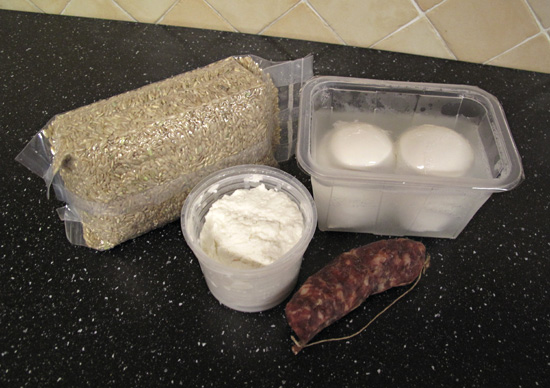
by Maureen | Feb 13, 2010 | Canals, Cheese, Discoveries, Featured Articles, Food!, Journal, Photos, Shopping & Markets
Saturday. Clear blue skies. About 50 degrees. Yes!
I headed down the canal on my bike, but decided on a change of scenery and followed the path I learned about from Angelo, my surprise tour guide in mid-January. The one lane road wound though small towns and rice fields. I found my way back to the same old “cascina” (large, formerly-fortified farm) that Angelo had shown me. The farm store had been closed that time before, and though they were closed again, a young woman came out of the house and welcomed me into the shop.
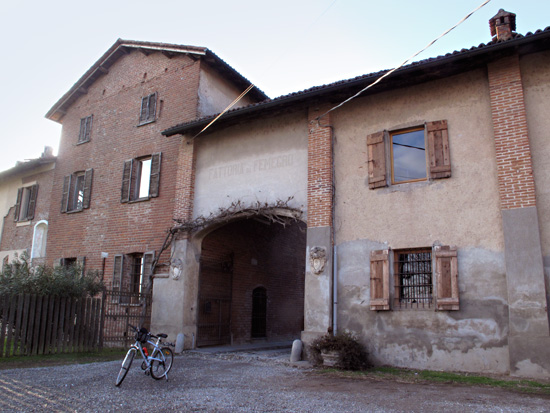
“What do you recommend?”, I asked her. She pointed out all of their own farm-produced foods and I selected fresh ricotta, fresh mozzarella, brown rice and salami. What could be better?!

I found a way to secure the little bundle on my bike and continued my ride. There was a woman on a pink scooter. A lawn hosting 4 peacocks. An old tile roof warming 3 black cats. 1 Woman on a bike. Swelling buds on the trees. And a stop to say “hello” to Padre Pio at his shrine in Zibido San Giacomo. What a day!
Gauging the position of the sun and the remaining daylight and warmth, I went as far as Noviglio then turned around to head north back to home.
The very first thing upon coming in the door was to open the ricotta and mozzarella and have a taste. OH…MY! That fresh ricotta was better than most ice cream. I simply got myself a spoon and started eating it. Wow. Delicious. And the salami was good, too.
I’m really liking this. Go for a bike ride and, not far out of the city, pick up home grown rice and fresh ricotta cheese. (This is so unlike my previous life experience.)

by Maureen | Feb 8, 2010 | Discoveries, Featured Articles, Graffiti & Street Art, Graphics, Incredible Locations, Journal, Photos, Sanremo
As a designer, I’m enchanted by the signage I see around Italy and France and love to stumble across old signs that haven’t been tampered with or “updated”. They have such flavor and style.
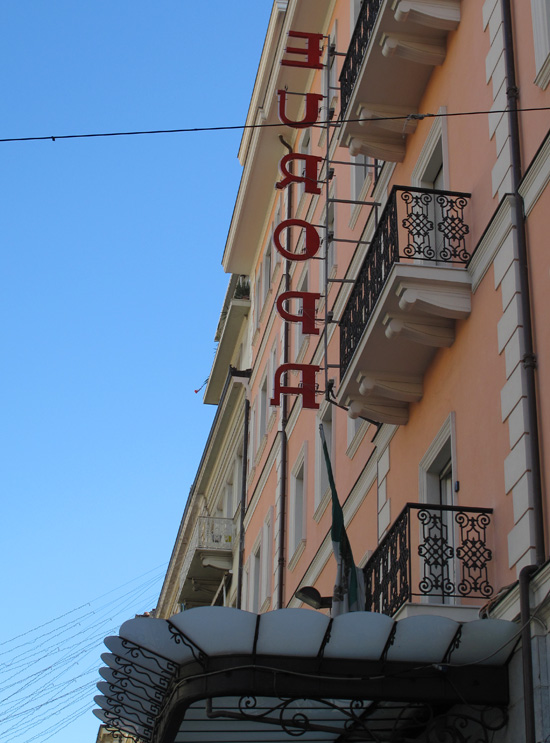
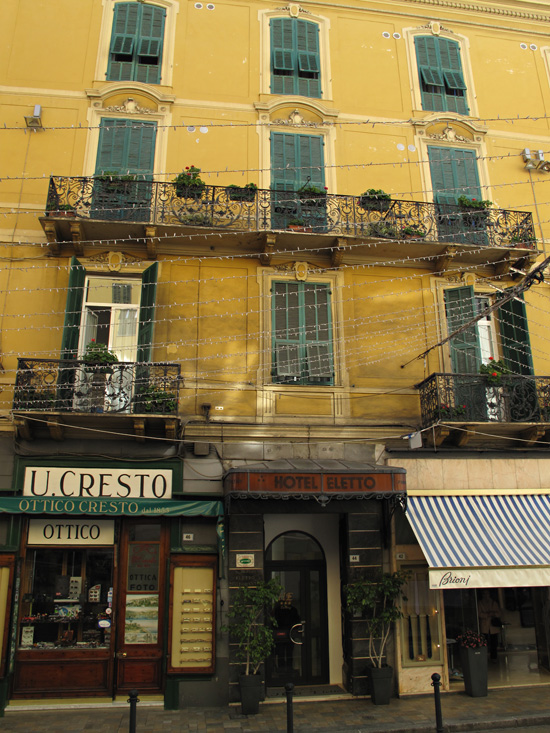
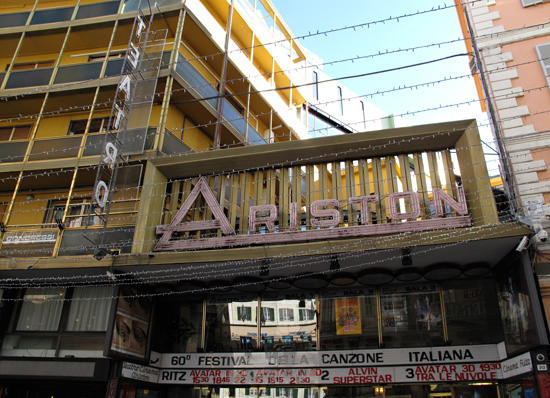
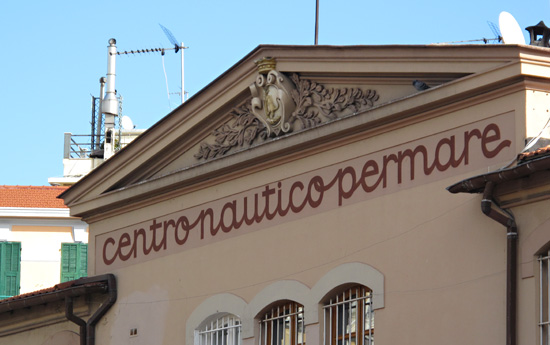
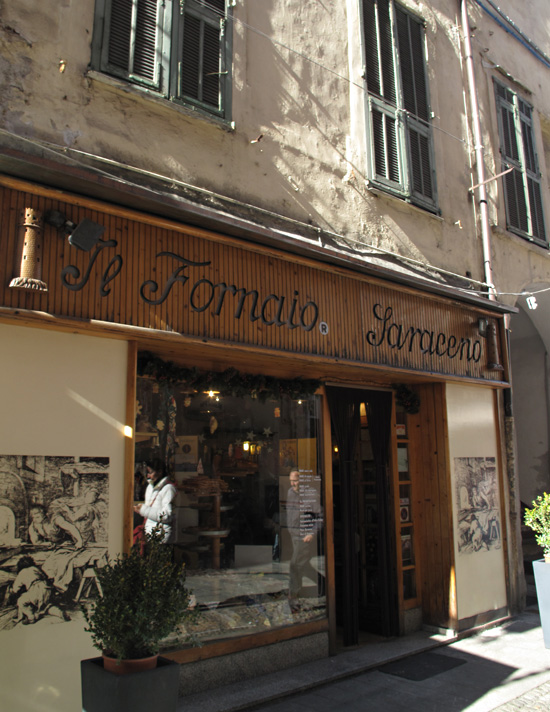
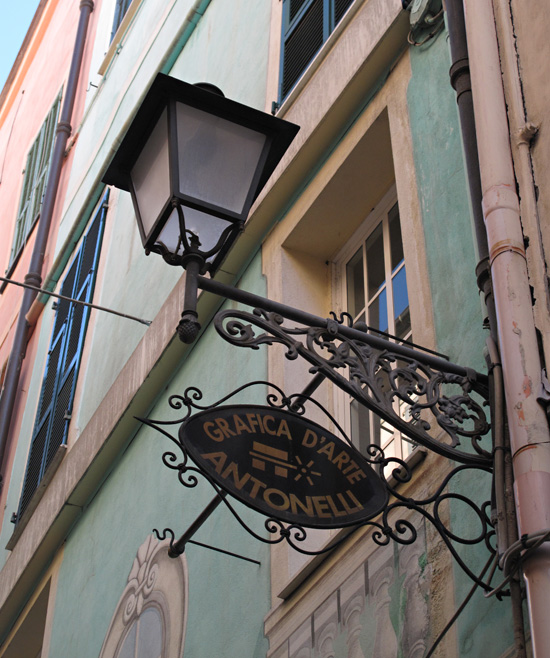
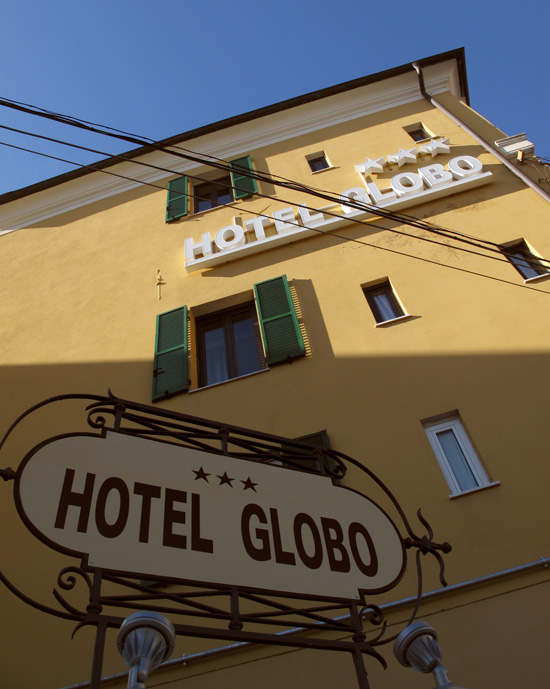
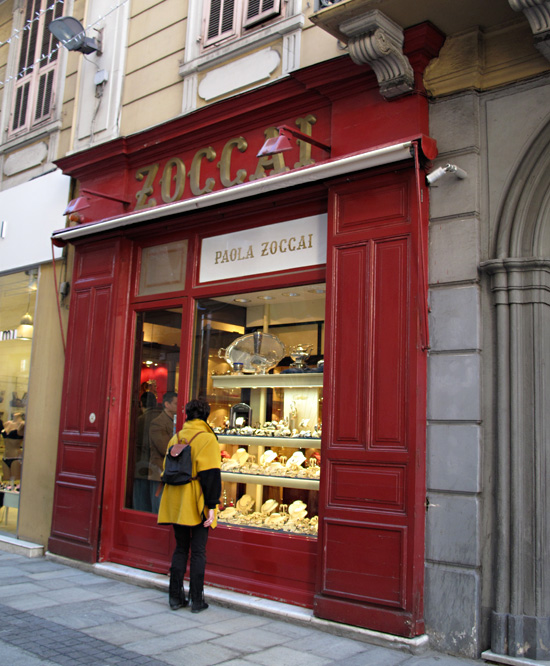

by Maureen | Feb 8, 2010 | Discoveries, Featured Articles, Incredible Locations, Journal, Monte-Carlo Monaco, Photo of the Day, Photos
We continued on to Monaco and the Casino Monte-Carlo. Who’d have imagined? All of us commented on the richness so thick you could cut it with a knife, that you could smell the money in the air. Subtlety and understatement are not included in the vocabulary of this pinpoint country. Monaco is a place of overstated extravagance.
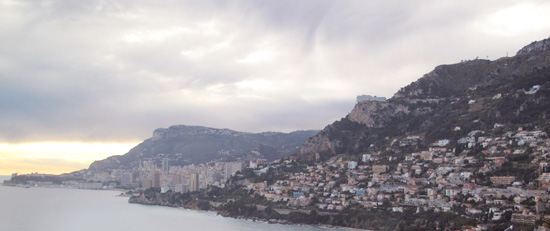
Monaco is the cluster of high-rises tucked into the rounded bay in the distance.
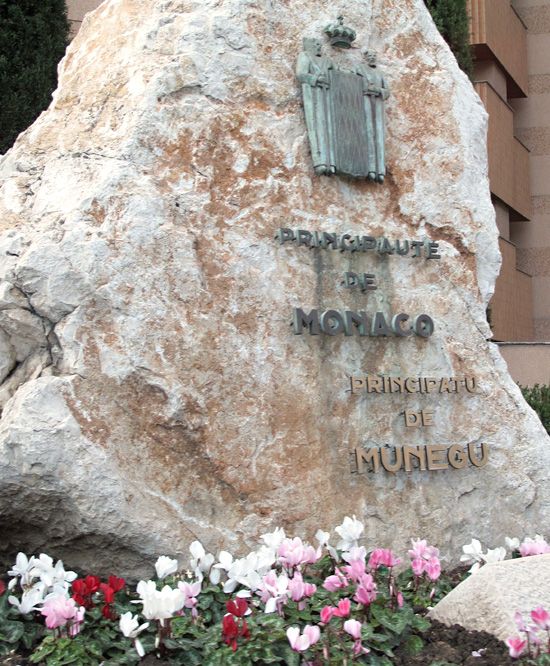
This is the marker stone as we entered into the principality of Monaco.
This small, independent principality is formed of a half-moon bit of the southeastern shore of France, not far from the border into Italy. There are two grand marinas hosting yachts beyond belief. Hotels circle the casino; their other homes are all the great cities of the world. The Grand Prix route is painted with the racer’s checkboard. All the finest shops for jewels and clothing have a presence in Monte-Carlo.
Monaco (and the district of Monte-Carlo) are Disneyland-style, exaggerated caricatures of way-over-the-top excess. For me, I can only imagine going there to drop my jaw, marvel at the ornamentation and know that I’ve seen it. I can’t imagine making it a serious destination, because it’s so far outside of my reach, my comprehension or even my desire.
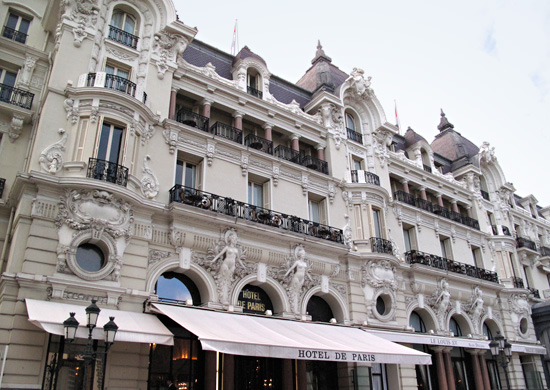
The front entrance of the Hotel De Paris, across the drive from the Casino Monte-Carlo.
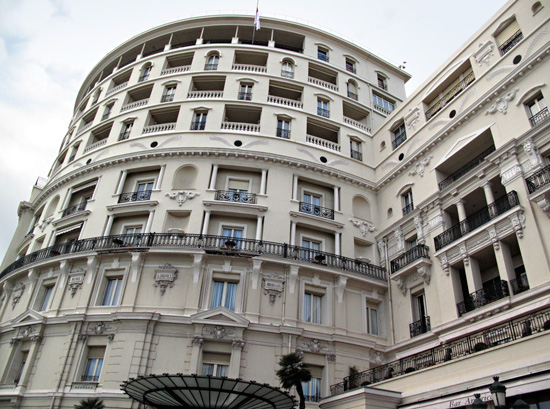
The seaside face of the Hotel De Paris.
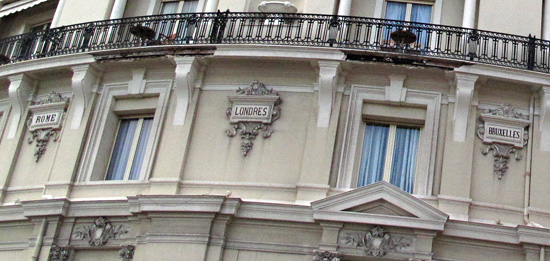
Grand city names round the arc of the Hotel De Paris.
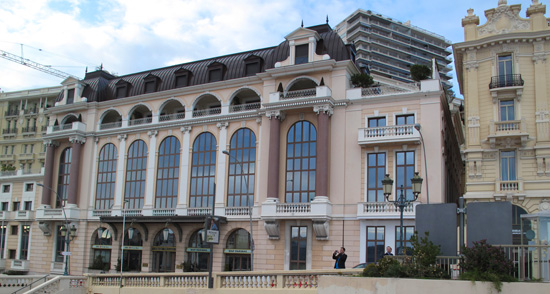
Even the newer construction reflects the style and extravagance of the old.
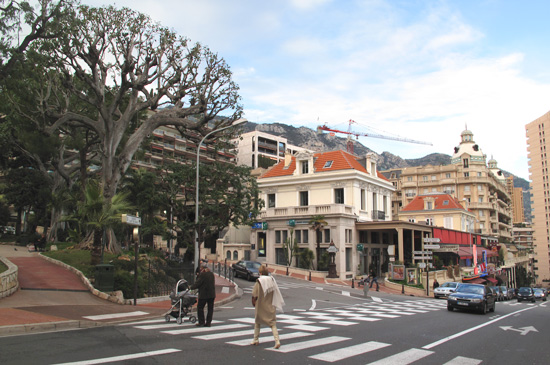
Checkerboard patterning on the Grand Prix raceway route.
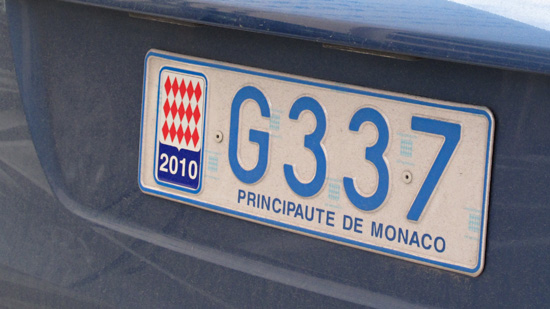
The Principality of Monaco.
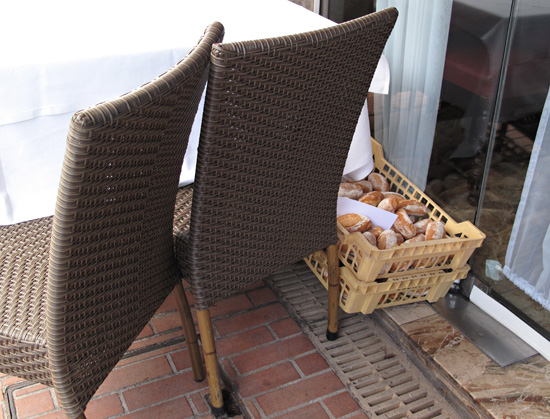
“Yes, we’d like to order some bread for the restaurant tonight.” “OK. No problem. We’ll bring it by and leave it outside by the door.” “Great. Thanks.” (Would this ever be allowed in the U.S.?)
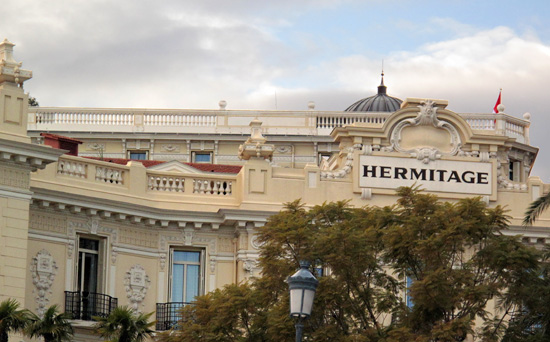
I’d heard of the Hermitage for years. Here it is.
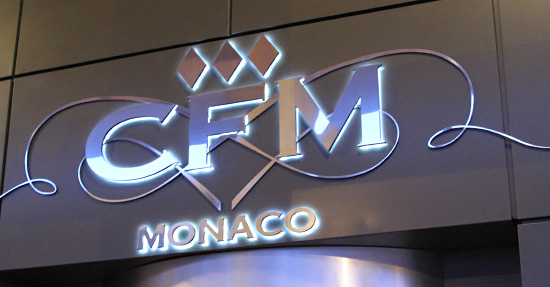
Even the signage has the same lux feel.
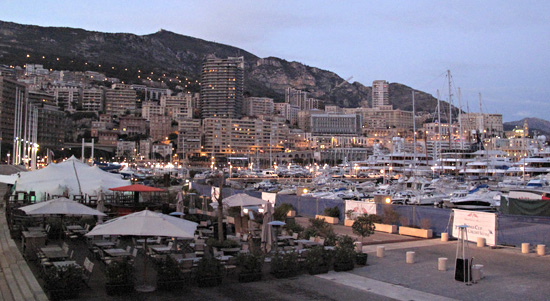
We got around to the other side of the bend in the bay just after sunset.
Monaco official website
Monte-Carlo official website

by Maureen | Jan 26, 2010 | Bergamo, Discoveries, Featured Articles, Incredible Locations, Journal, Photos
After rising up from the valley floor in the funiculare tram, a short walk brings you to the old plaza, la Piazza Vecchia. Encircled by palaces, a bell tower and a colonnaded portico, the space is punctuated at its center by a Baroque fountain from the late 1700s. The piazza is the heart of the city.Those palaces now house restaurants, hotels, a school and a museum.
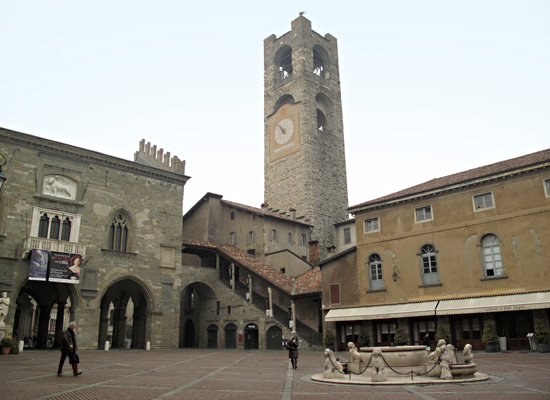
Passing through the portico (at the left in the photo above, under the banners) you find a white marble sundial that was set into the ground in 1798. It points the way north. (It seems to have been restored in 1982.)
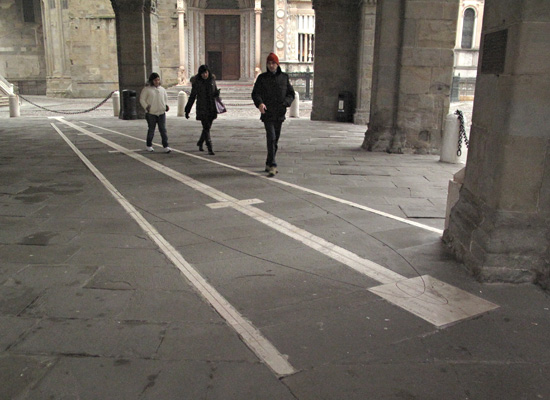
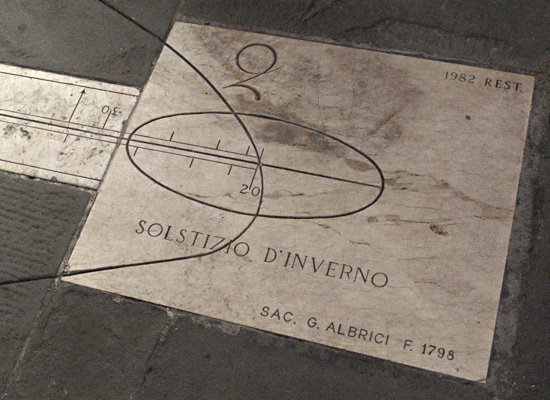
Just beyond the other side of the portico, you step into the Piazza del Duomo, the Plaza of the Cathedral. In mediaeval times this little square was at the political, commercial and religious heart of town. Facing south into the piazza, from your left to right is the Cattedrale di Bergamo (il Duomo), the Basilica di Santa Maria Maggiore, the Cappella Colleoni and the Battistero (Bapistry).
Cattedrale di Bergamo – il Duomo
The ceiling of the Duomo featured gilt patterning and accents to its carved decorations surrounding painted scenes.
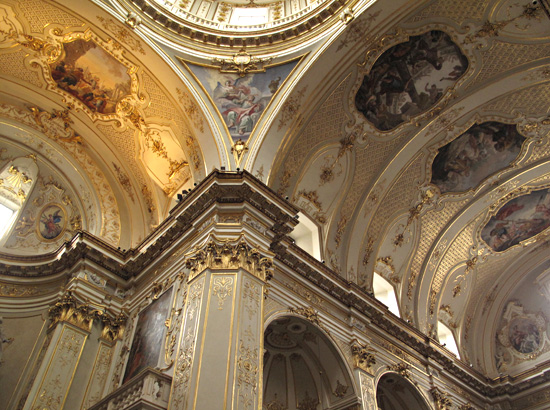
I have a real soft spot for the shrines to Mary. This Madonna della Pietá is in an elaborately carved and embellished side altar.
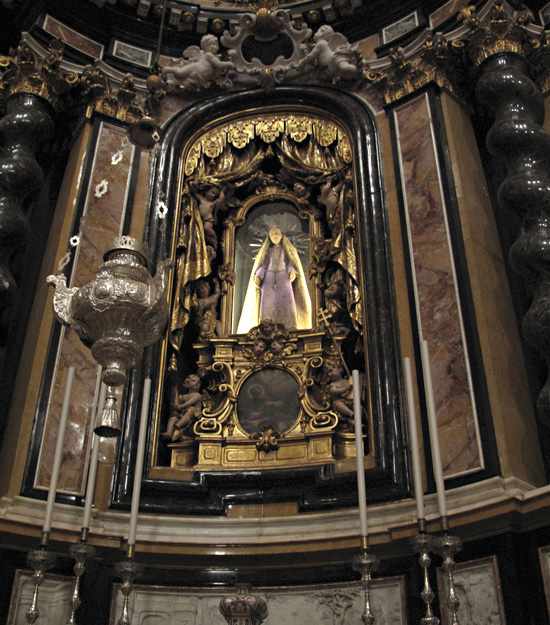
While in the cathedral, I heard chanting and thought perhaps they were playing a recording “for ambience”. No. I followed the singing which lead me down a staircase near the altar. I came to a very modern underground chapel and 50 Nuns at mass, surrounded by a dozen sarcophaghi.
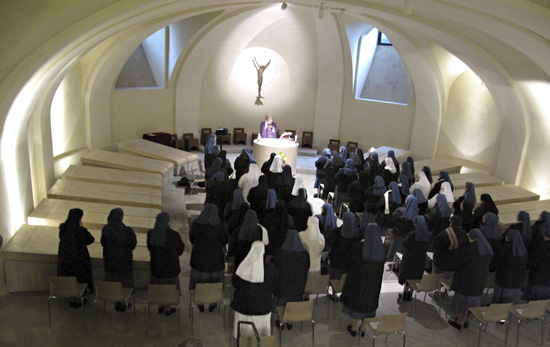
The dominant presence in the Piazza del Duomo is the union of entrances for the Basilica di Santa Maria Maggiore (at left in the photo below) and the Cappella Colleoni (at right).
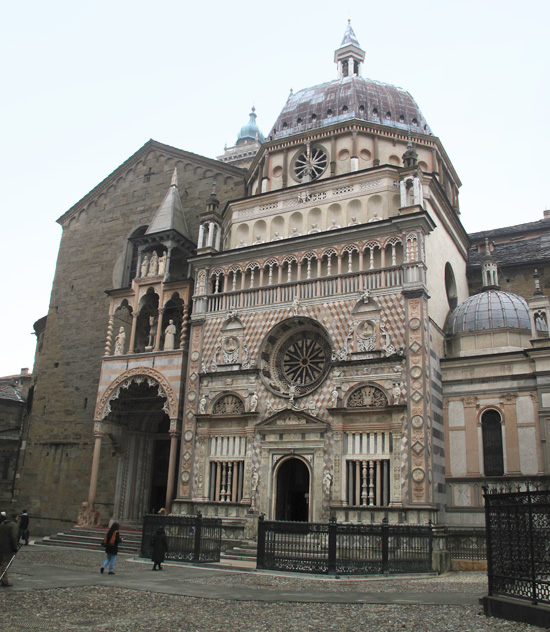
Basilica di Santa Maria Maggiore
The Basilica entry is fairly modest and overshadowed by the Chapel entry at its side. It opens, however, into a great, embellished space.
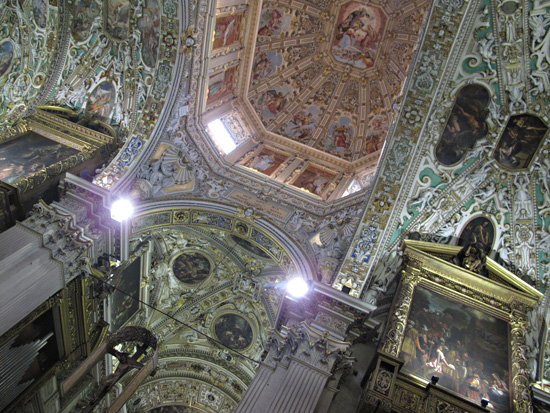
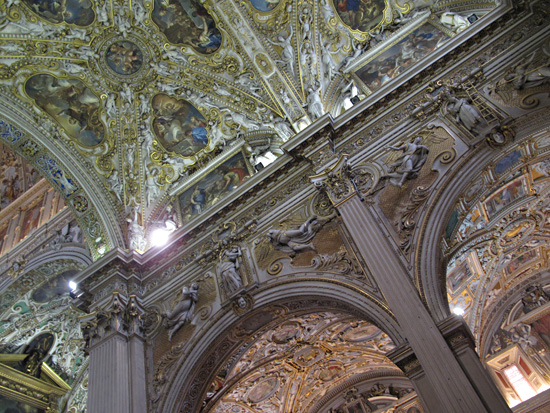
Here’s a shot of the crucifix that hangs over the central altar. (Note the skull and crossbones at the base of the cross.)
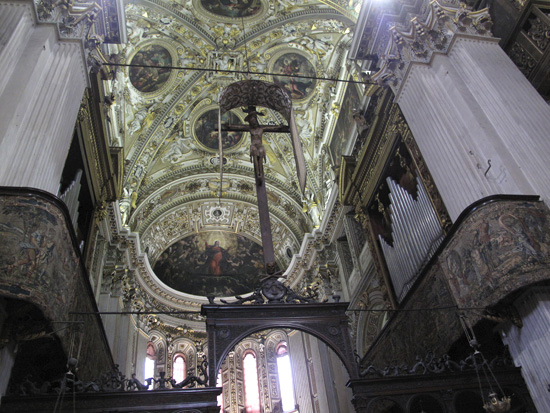
All vertical walls are covered with pictorial tapestries. (Although it was still very cold in there!)
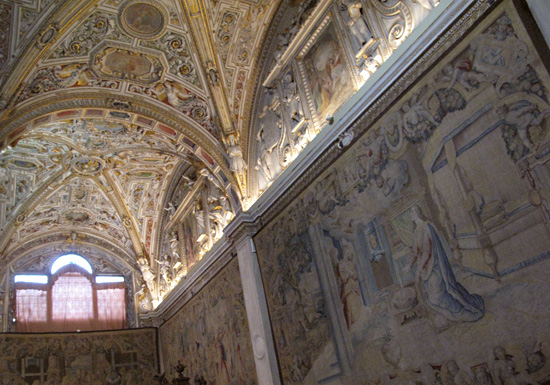
Here is historic Bergamo’s answer to today’s compact PDA/Calendar. This is how they note the times of the masses for week days and weekends.
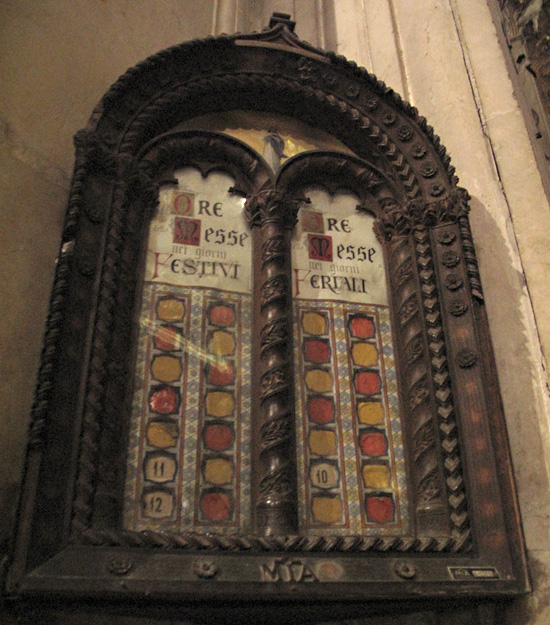
On the outside wall of the Basilica, just to the left of the front door, are permanently-mounted, flat bars of iron that are measuring devices from the Middle Ages. (I can’t find any information about their purpose or unit-of-measure.)
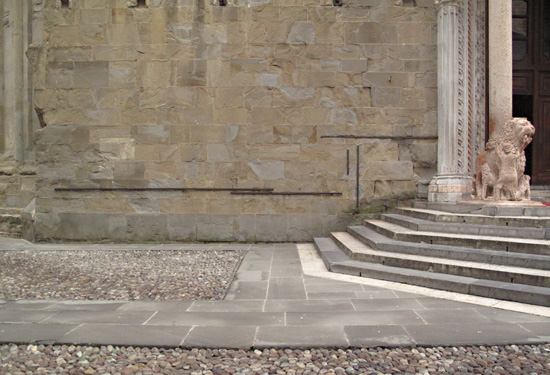
“The Weaver’s Wall” and “the Weaver’s Comb.” (?)


Cappella Colleoni
From a Wikipedia entry: “Dedicated to the saints Bartholomew, Mark and John the Baptist, it was built in 1472-1476 as the personal shrine for the famous condottiere Bartolomeo Colleoni, a member of one of the most outstanding families of the city, and his beloved daughter Medea. The site chosen was that of the sacristy of the nearby church of Santa Maria Maggiore, which was demolished by Colleoni’s soldiers.”
With its 3-D lozenge pattern, the repetition of columns, the figurative sculptures, rose windows, domes and bas-relief panels, no one and no building could compete for stature against this chapel. I think that one could study it all day, as well as the decorated fence surrounding the chapel entry. (No photos were allowed inside.)
The Baptistry
My favorite part of the Baptistry is the decorative ironwork fence around its octagonal shape/
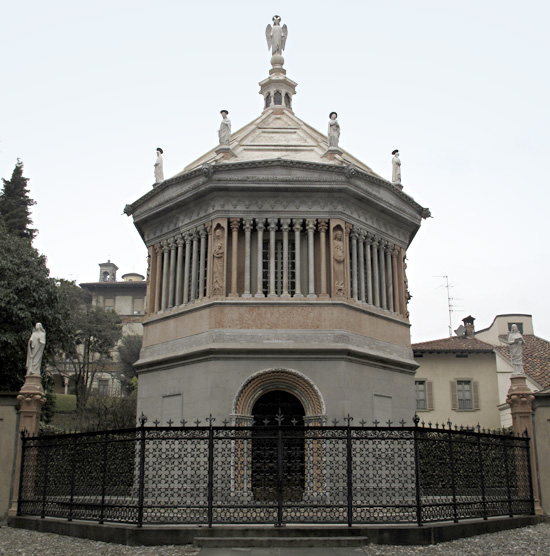
– – –
Note: So very many images and scholarly descriptions are available online that it would feel redundant if I tried to duplicate what’s already been said. I would rather toss out my own personal impressions and show what catches MY eye and mind, and provide enough information so that a blog reader could do their own further research.












































































